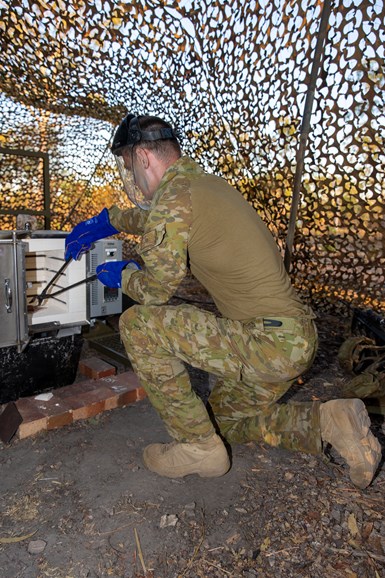Australian Army Tests Metal 3D Printing in Latest Field Trial
The ‘WarpSPEE3D’ program aims to significantly increase unique parts available to the Army compared to what the regular supply chain can provide.

A ‘WarpSpee3D’ 3D metal printer was put through its paces by the Australian Army.
A ‘WarpSpee3D’ 3D metal printer has been deployed for its second trial and been put through its paces by the Australian Army during a two-week field exercise in the extreme heat and humidity of the Northern Territory.
The printer arrived in Darwin in early June for the first trial and forms the backbone of the Army’s developing 3D printing capability. WarpSpee3D is said to be the world’s first large-format metal 3D printer to use cold spray technology that enables significantly faster and more cost-effective metal part production than traditional manufacturing.
Developed by Spee3D, an Australian manufacturer of metal additive manufacturing technology, the printer is capable of printing large metal parts up to 40 kg at a speed of 100 g per minute. After receiving a number of upgrades and modifications in the two months since its first deployment, the WarpSpee3D print cell deployed as part of 1 CSSB’s larger Brigade Support Group to various field locations in temperatures up to 37°C and 80% humidity, while printing and machining genuine military metal parts.
The company says the Spee3D printers make metal parts the fastest way possible, leveraging metal cold spray technology to produce industrial quality metal parts in just minutes, rather than days or weeks. This process harnesses the power of kinetic energy, rather than relying on high-power lasers and expensive gases, enabling 3D metal printing in the field at affordable costs.
The trials are part of the Australian Army’s $1.5 million investment in a Spee3D technology pilot announced in February 2020. The 12-month trial is designed to test the feasibility of deploying 3D metal printers both on base and in the field. Spee3D partnered with the Advanced Manufacturing Alliance (AMA) and Charles Darwin University (CDU) to deliver the program with soldiers from the Australian Army’s 1st Brigade training in 3D printing at CDU since February.
The program aims to significantly increase unique parts available to the Army compared to what the regular supply chain can provide.
“This second field deployment proves our technology is a genuine solution for expeditionary metal 3D printing. This two-week trial demonstrates the WarpSpee3D is a robust workhorse that is capable of printing real parts and solving real problems in the field,” says Byron Kennedy, Spee3D CEO. “It also proves that soldiers can take control of the whole workflow of creating the spare parts they need, from design to printing and post-processing, right here where they need them.”
Related Content
-
At General Atomics, Do Unmanned Aerial Systems Reveal the Future of Aircraft Manufacturing?
The maker of the Predator and SkyGuardian remote aircraft can implement additive manufacturing more rapidly and widely than the makers of other types of planes. The role of 3D printing in current and future UAS components hints at how far AM can go to save cost and time in aircraft production and design.
-
Quadrus: Powder Management Tactics for Tungsten Rhenium and Other AM Alloys
The expert in additive manufacturing of high-value parts for the Defense Department often must change from one exotic material to another in its powder bed machines. Cleaning is a core competency. Here are lessons of this company’s system for working with an ever-changing mix of 3D printed alloys.
-
Neighborhood 91 Expands, With Metal Powder Works and HAMR Now Open
Ribbon cuttings for the Pittsburgh campus's newest tenants coincided with the announcement that a DOD-funded resilient manufacturing program will also be developed at the site.













